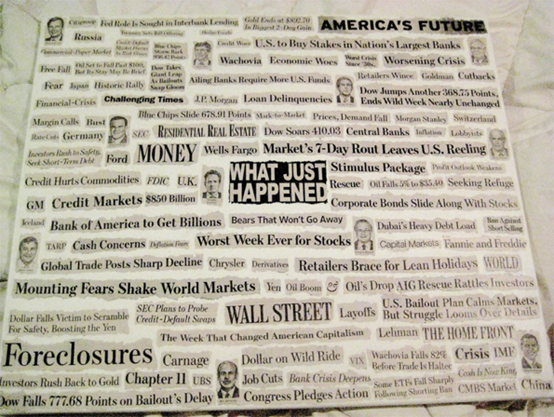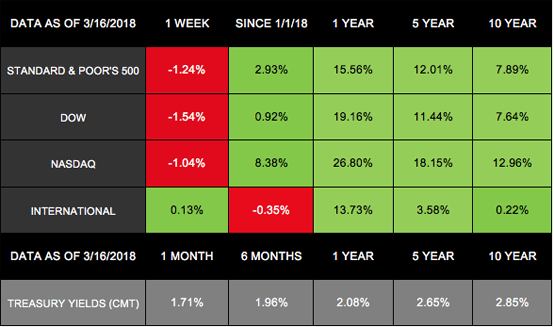Markets were up on Friday, but domestic stocks lost ground for the week as political turmoil and potential trade wars weighed on investors’ minds.[1] The S&P 500 dropped 1.24%, the Dow gave back 1.54%, and the NASDAQ decreased 1.04%.[2] International stocks in the MSCI EAFE barely avoided losses with a 0.13% gain.[3]
1. Mixed Performance Results [dt_gap height=”5″ /]
Overall, we received a variety of mixed data last week:
Down
- Housing starts missed expectations and fell 7%.[4]
- Retail sales were lower than expected.[5]
Up
- Consumer sentiment hit its highest reading since 2004.[6]
- Domestic factory production beat expectations.[7]
But data reports were not the only detail worth noting last week. We also marked the 10-year anniversary of Bear Stearns’ collapse.
2. A Look Back
For 85 years, Bear Stearns was a respected institution that became one of the world’s largest investment banks. When the housing market crashed in 2007, the firm realized it had taken on far more risk than planned.[8] As a result, the firm ran out of cash, and on March 16, 2008, JPMorgan bought the previously valuable company for only $2 a share. In retrospect, Bear Stearns’ collapse was the first real glimpse of the pending Great Recession.[9]
Less than a year later, markets hit bottom on March 9, 2009. In the years since, stocks have corrected multiple times, losing over 10%. But, they have never lost 20% to push into a bear market – meaning we’re in the midst of the 2nd-longest bull market since World War II.[10]
Time can make some memories fade, but we doubt that anyone who experienced the Great Recession forgets how challenging and scary it felt.
Here’s what headlines were telling us:

Source: http://www.businessinsider.com/what-the-headlines-looked-like-at-the-height-of-the-2008-financial-crisis-2017-3
Despite the market losses and economic turmoil, the Great Recession was also a powerful reminder of Warren Buffett’s advice: “Be fearful when others are greedy and greedy when others are fearful.[11]”
While the markets seemed to be in a free-fall, allowing emotion to dictate investing choices was easy. But anyone who escaped the markets’ bottom missed an incredible growth opportunity.
Nine years after the S&P 500 hit its low, the index was up 390% – and was 122% higher than its record close before the Great Recession began. So, while the collapse was painful, stocks weathered the storm, sailing far beyond where they were before.[12] The economy is also in a very different place than it was a decade ago.
Where We Are Now
- Job Growth: February was the 89th-straight month where the economy added jobs.
- Unemployment: The current unemployment rate remains at its lowest level in 17 years.[13]
- Gross Domestic Product: The U.S. economy has expanded every year since 2010.[14]
Of course, we recognize that the economy is not perfect and still has room to improve. But, we also want to remind you of how far we’ve all come since the Great Recession first began. If you’d like to take a closer look at your own progress or plans for the future, we are always here to talk. [dt_gap height=”10″ /]
ECONOMIC CALENDAR
Wednesday: FOMC Meeting Announcement, Existing Home Sales
Thursday: Jobless Claims
Friday: Durable Goods Orders, New Home Sales[dt_divider style=”thick” /]

Notes: All index returns (except S&P 500) exclude reinvested dividends, and the 5-year and 10-year returns are annualized. The total returns for the S&P 500 assume reinvestment of dividends on the last day of the month. This may account for differences between the index returns published on Morningstar.com and the index returns published elsewhere. International performance is represented by the MSCI EAFE Index. Past performance is no guarantee of future results. Indices are unmanaged and cannot be invested into directly.[dt_divider style=”thick” /]
Investing involves risk including the potential loss of principal. No investment strategy can guarantee a profit or protect against loss in periods of declining values.
Investment advisory services and insurance services are provided through The Retirement Solution Inc., a Registered Investment Advisor.
Any economic and/or performance information cited is historical and not indicative of future results. The Retirement Solution Inc. is an investment advisor registered in each state The Retirement Solution Inc. maintains client relationships.
Diversification does not guarantee profit nor is it guaranteed to protect assets.
International investing involves special risks such as currency fluctuation and political instability and may not be suitable for all investors.
The Standard & Poor’s 500 (S&P 500) is an unmanaged group of securities considered to be representative of the stock market in general.
The Dow Jones Industrial Average is a price-weighted average of 30 significant stocks traded on the New York Stock Exchange and the NASDAQ. The DJIA was invented by Charles Dow back in 1896.
The Nasdaq Composite is an index of the common stocks and similar securities listed on the NASDAQ stock market and is considered a broad indicator of the performance of stocks of technology companies and growth companies.
The MSCI EAFE Index was created by Morgan Stanley Capital International (MSCI) that serves as a benchmark of the performance in major international equity markets as represented by 21 major MSCI indices from Europe, Australia, and Southeast Asia.
The 10-year Treasury Note represents debt owed by the United States Treasury to the public. Since the U.S. Government is seen as a risk-free borrower, investors use the 10-year Treasury Note as a benchmark for the long-term bond market.
Opinions expressed are subject to change without notice and are not intended as investment advice or to predict future performance.
Past performance does not guarantee future results.
You cannot invest directly in an index.
Consult your financial professional before making any investment decision.
Fixed income investments are subject to various risks including changes in interest rates, credit quality, inflation risk, market valuations, prepayments, corporate events, tax ramifications and other factors.
These are the views of Platinum Advisor Strategies, LLC, and not necessarily those of the named representative,
Broker dealer or Investment Advisor, and should not be construed as investment advice. Neither the named representative nor the named Broker dealer or Investment Advisor gives tax or legal advice. All information is believed to be from reliable sources; however, we make no representation as to its completeness or accuracy. Please consult your financial advisor for further information.
By clicking on these links, you will leave our server, as the links are located on another server. We have not independently verified the information available through this link. The link is provided to you as a matter of interest. Please click on the links below to leave and proceed to the selected site..
[1] www.cnbc.com/2018/03/16/us-stock-futures-dow-data-and-politics-on-the-agenda.html
http://performance.morningstar.com/Performance/index-c/performance-return.action?t=@CCO
[3] www.msci.com/end-of-day-data-search
[4] www.cnbc.com/2018/03/16/us-stock-futures-dow-data-and-politics-on-the-agenda.html
[6] www.cnbc.com/2018/03/16/us-stock-futures-dow-data-and-politics-on-the-agenda.html
[8] www.investopedia.com/terms/b/bear-stearns.asp
[10] www.chicagotribune.com/business/sns-bc-us–financial-markets-bull-market-birthday-20180309-story.html
[11] www.investopedia.com/articles/investing/012116/warren-buffett-be-fearful-when-others-are-greedy.asp
[13] money.cnn.com/2018/03/09/news/economy/february-jobs-report/index.html
